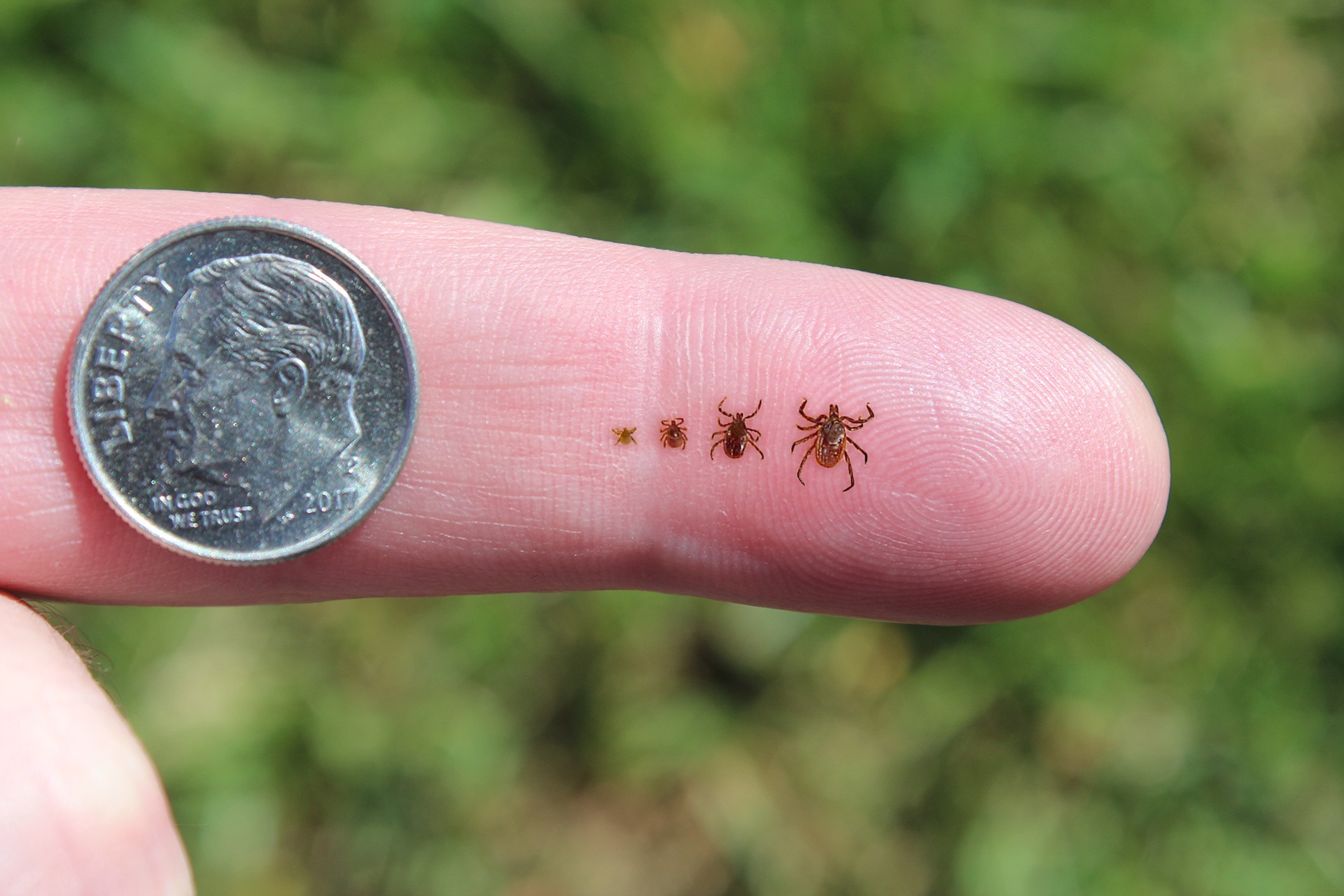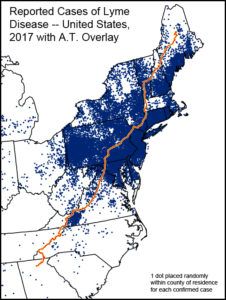Tick-Borne Diseases
Ticks
Tick-Borne Diseases
The health hazard you are most likely to encounter while hiking the Appalachian Trail is contracting a tick-borne disease. Multiple species of ticks can be found in every one of the 14 states that the A.T. passes through.

Black-legged Deer Ticks
Although tick-borne diseases are usually quite treatable when caught early, symptoms can be severe and long-lasting, and a few of the less common tick-borne diseases can be life threatening if not treated properly, especially for those with compromised immune systems.
Lyme disease, carried by the deer tick (also known as the black-legged tick) is the most common. However, there are several tick-borne illnesses present on the A.T. and combinations of diseases may occur from a single tick bite.
For comprehensive information about tick-borne diseases and symptoms, click here.
The characteristic “bulls-eye” rash sometimes occurs with Lyme disease, but not always. Symptoms that may indicate tick-borne illnesses and a need for medical attention include flu-like symptoms such as fever, chills, headache, joint pain, muscle aches and fatigue. For many tick-borne illnesses, symptoms may continue for months or even years and treatment may be difficult. Treatment is most effective immediately after a tick bite.
 Most humans are infected by nymphs, which are about the size of a poppy seed and difficult to see. The most common time of year to be bitten by a tick is from May through July, but you can potentially be bitten by a tick any time of year, even in cold temperatures.
Most humans are infected by nymphs, which are about the size of a poppy seed and difficult to see. The most common time of year to be bitten by a tick is from May through July, but you can potentially be bitten by a tick any time of year, even in cold temperatures.
Prevention is the best strategy! Your chances of being bitten by a tick can be greatly reduced by taking these precautions:
- Wear clothing treated with permethrin (kills or repels ticks on contact). At InsectShield.com, you can purchase pre-treated clothing, buy spray to apply to clothing yourself, and/or send in your own clothing to be factory-treated. Use promo code “ATC” for a 15% discount on your first purchase. In addition, 10% off all sales purchased through these links will be donated back to ATC.
- Treated trousers or bug-net pants over shorts are very effective and the bug-net pants allow for ventilation on warm, humid days. Wear long pants tucked into socks, and shirt tucked into pants (ticks crawl up); long-sleeved shirts, especially when treated with permethrin, offer more protection than short sleeves.
- Spray-on permethrin can also be used to treat your pack and outer tent floor.
- Wear light-colored clothing; ticks can most easily be spotted against a lighter color.
- Use insect repellent that contains 20 to 30 percent DEET or picaridin on exposed skin.
- Check for ticks frequently. Removing an embedded tick as soon as possible reduces risk of illness.
- Use fine-tipped tweezers or a tick key to lift under the mouthparts in a slow, steady pull.
- Choose areas and times of lowest risk. Ticks are generally found in areas under 2000-2500′ elevation, and most cases are reported from May through July, when nymphs are active. States from Virginia through Vermont have the highest incidence of Lyme disease. However, Lyme disease and other tick-borne illnesses can be contracted in any A.T. state at any time of year.
- Avoid sitting directly on the ground or logs; sit on a pad treated with permethrin instead.
- Once inside, put clothes in the dryer on high heat for 60 minutes to kill any remaining ticks.
- Check your body for ticks after being outdoors. Conduct a full body check upon return from hiking. Use a hand-held or full-length mirror to view all parts of your body. Check these parts of your body and your child’s body for ticks:
- Under the arms
- In and around the ears
- Inside belly button
- Back of the knees
- In and around the hair
- Between the legs
- Around the waist
- Shower as soon as possible after being exposed to ticks; showering within two hours of coming indoors has been shown to reduce your risk of getting Lyme disease and may be effective in reducing the risk of other tickborne diseases. Showering may help wash off unattached ticks and it is a good opportunity to do a tick check.
- Consider leaving your dog at home. If you are hiking with a dog, keep in mind they will attract ticks and can put you at a higher risk for coming in contact with them. Be sure to check your pup as often, if not more often, than you check yourself.
For an in-depth article about Lyme disease on the A.T., click here.

Bit by a tick on the Appalachian Trail?
The Center for Disease Control (CDC) has an interactive Tick Bite Bot that can guide you on removing attached ticks and help you determine when to seek health care, if appropriate, after a tick bite.

